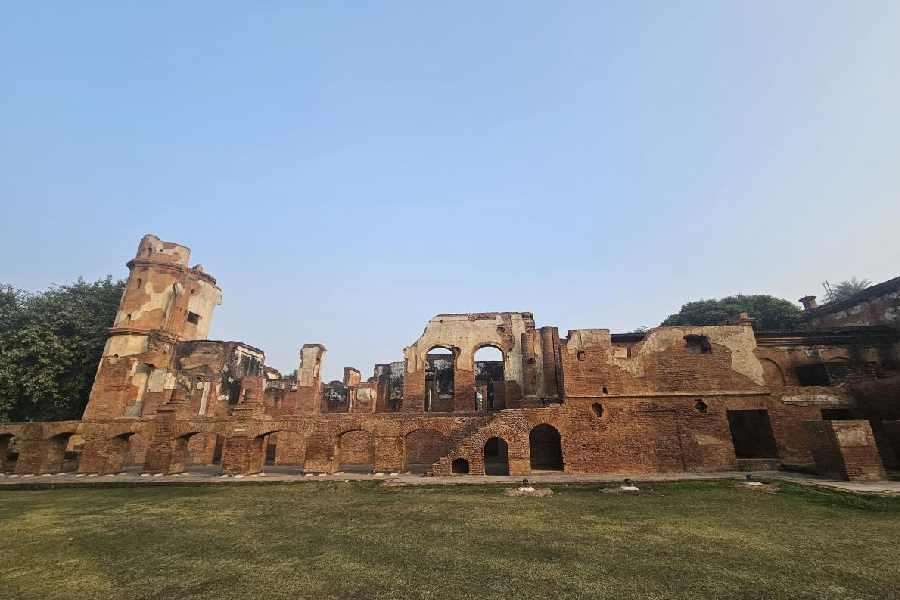Bonbiharibabu was on my mind. The setting was rather apt to reminisce about this villainous character — one of Feluda’s formidable adversaries — whose misdeeds have been wolfed down by generations of readers of Satyajit Ray’s Badshahi Angti. I was standing among the ruins of the Residency in Lucknow, the site of a ferocious encounter between patriotic rebels and the Raj’s emissaries during the Great Revolt, also the place where Bonbiharibabu delivered a tidy little lecture on the history of that tumultuous battle.
On my right stood the remains of what must have been the billiards room that Bonbiharibabu had referred to: for the walls bore the signature of bombardment; Bonbihari had urged Felu and Topshe to gaze at those blackened marks.
A few steps from there brought me to the decrepit, but still majestic, Dr Fayrer’s House. Fayrer was the resident surgeon during the siege of 1857, attending to, as Bonbiharibabu had mentioned, not only the trapped, panicking sahibs and memsahibs but also a seriously wounded Henry Lawrence, British defender of the Residency. One of the chambers in Fayrer’s House, located on a subterranean level, resembled what a board set up by the conservators claimed to be the tahkhana: an underground room meant to shelter the Residency’s women and children from Lucknow’s cruel summer. In that angry summer of 1857, Lawrence had perished in this very room.
Walking further, along the carpet-like lawns and ancient trees that envelope, among other structures, a banquet hall, the imposing Treasury, an exquisitely chiselled mosque, the Sheep House, and the presciently-named Slaughter House, one reaches at the tail-end of the sprawling complex a small cemetery wherein lie the remains of the victors and the vanquished. Here, in the falling light, stood a solemn plaque plastered on a brick wall, commemorating members of the Garud Pultun — nine havildars, eight naiks, five drummers, 24 sepoys — Indians who fell to bullets, swords and cannons of their brother revolutionaries in the service of a foreign Company. Asleep next to them is a young lieutenant, close to whom are the graves of British women who perished in the bloodbath.
As one tiptoes through the cemetery, scanning the fading details on the tombs and obelisks, it is possible that Bonbiharibabu would come to mind, once again. Readers of Badshahi Angti will remember the triumphant note in his baritone as he recounted the courage of the rebels. But history — tragic history — has a funny way of blurring the lines between heroes and villains, aggressor and aggrieved, master and subject. The brutality of the battle and its residual echoes — it is not difficult to imagine children and their nurses cowering inside Fayrer’s House — evoke an alchemy of pride at the heroism of the sepoys that is, nonetheless, tinged with sadness for the defendants.
A couple of hours of walking and reflecting on tangled history led to the inevitable reaction in my Bengali frame: famishment. But here too, Badshahi Angti’s creator and its characters, just like the Residency’s defenders, came a cropper. Astonishingly, this adventure of Felu has a rather miserly description of Lucknow’s diverse and heady aromas, with Doctor Shrivastav, a Lucknowite, making a passing mention of sandila laddoo, gulabi rewdi and bhuna peda. The good osteopath forgot to mention an entire list of other heavenly, saccharin delicacies.
In front of Gol Darwaza, the navel to old Lucknow’s belly, stand rows of vendors selling the ethereal concoction of airy, frothy cream topped with dry fruits and flavoured with a hint of saffron — the seasonal delight called malai makhan. If one heads north from there, on a rather unsavoury stretch turned saffron by beetle juice spittle, the air heavy with the aroma of not ittar but litter — yet Lucknow stands tall on the Clean Air City index — one would reach, as is always the case in New India, a shelter that goes by the name of Ram. Only that Ram Ashray’s charms are decidedly secular: it is a sweetmeat shop lined with assorted trays of kali gajar ka halwa, batisa, malai gilori, bahurani laddoo, anjeer supari and so on.
That day, standing with a warm thonga stuffed with malai gilori — a thin sheet of malai shaped like a paan stuffed with the delirious taste of pista, saffron, kaju and khoya — I was grateful that Lucknow’s numerous pleasures for my sweet tusk have survived many a siege, be it the one at the Residency or another unfolding, less than 150 kilometres away, in a city filled with a different scent of saffron.











